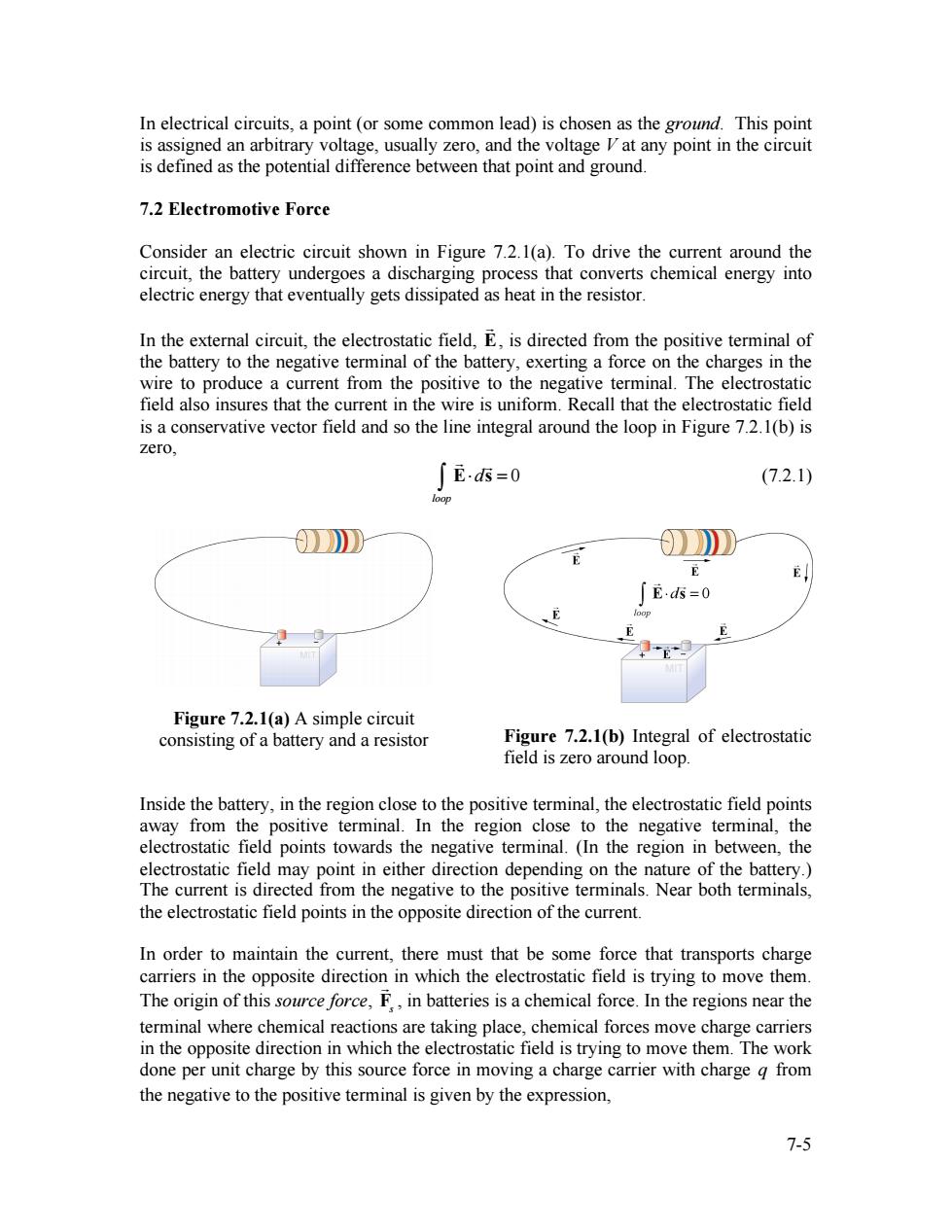正在加载图片...

In electrical circuits,a point(or some common lead)is chosen as the ground.This point is assigned an arbitrary voltage,usually zero,and the voltage Iat any point in the circuit is defined as the potential difference between that point and ground. 7.2 Electromotive Force Consider an electric circuit shown in Figure 7.2.1(a).To drive the current around the circuit,the battery undergoes a discharging process that converts chemical energy into electric energy that eventually gets dissipated as heat in the resistor. In the external circuit,the electrostatic field,E,is directed from the positive terminal of the battery to the negative terminal of the battery,exerting a force on the charges in the wire to produce a current from the positive to the negative terminal.The electrostatic field also insures that the current in the wire is uniform.Recall that the electrostatic field is a conservative vector field and so the line integral around the loop in Figure 7.2.1(b)is zero, ∫Es=0 (7.2.1) loop [E.ds=0 Figure 7.2.1(a)A simple circuit consisting of a battery and a resistor Figure 7.2.1(b)Integral of electrostatic field is zero around loop. Inside the battery,in the region close to the positive terminal,the electrostatic field points away from the positive terminal.In the region close to the negative terminal,the electrostatic field points towards the negative terminal.(In the region in between,the electrostatic field may point in either direction depending on the nature of the battery.) The current is directed from the negative to the positive terminals.Near both terminals, the electrostatic field points in the opposite direction of the current. In order to maintain the current,there must that be some force that transports charge carriers in the opposite direction in which the electrostatic field is trying to move them The origin of this source force,F,in batteries is a chemical force.In the regions near the terminal where chemical reactions are taking place,chemical forces move charge carriers in the opposite direction in which the electrostatic field is trying to move them.The work done per unit charge by this source force in moving a charge carrier with charge q from the negative to the positive terminal is given by the expression, 7-57-5 In electrical circuits, a point (or some common lead) is chosen as the ground. This point is assigned an arbitrary voltage, usually zero, and the voltage V at any point in the circuit is defined as the potential difference between that point and ground. 7.2 Electromotive Force Consider an electric circuit shown in Figure 7.2.1(a). To drive the current around the circuit, the battery undergoes a discharging process that converts chemical energy into electric energy that eventually gets dissipated as heat in the resistor. In the external circuit, the electrostatic field, E, is directed from the positive terminal of the battery to the negative terminal of the battery, exerting a force on the charges in the wire to produce a current from the positive to the negative terminal. The electrostatic field also insures that the current in the wire is uniform. Recall that the electrostatic field is a conservative vector field and so the line integral around the loop in Figure 7.2.1(b) is zero, E⋅d s = 0 loop ∫ (7.2.1) Figure 7.2.1(a) A simple circuit consisting of a battery and a resistor Figure 7.2.1(b) Integral of electrostatic field is zero around loop. Inside the battery, in the region close to the positive terminal, the electrostatic field points away from the positive terminal. In the region close to the negative terminal, the electrostatic field points towards the negative terminal. (In the region in between, the electrostatic field may point in either direction depending on the nature of the battery.) The current is directed from the negative to the positive terminals. Near both terminals, the electrostatic field points in the opposite direction of the current. In order to maintain the current, there must that be some force that transports charge carriers in the opposite direction in which the electrostatic field is trying to move them. The origin of this source force, Fs , in batteries is a chemical force. In the regions near the terminal where chemical reactions are taking place, chemical forces move charge carriers in the opposite direction in which the electrostatic field is trying to move them. The work done per unit charge by this source force in moving a charge carrier with charge q from the negative to the positive terminal is given by the expression